Looking for a Personalized Diet Plan?
Rice Calories, Nutrition, and Health Benefits
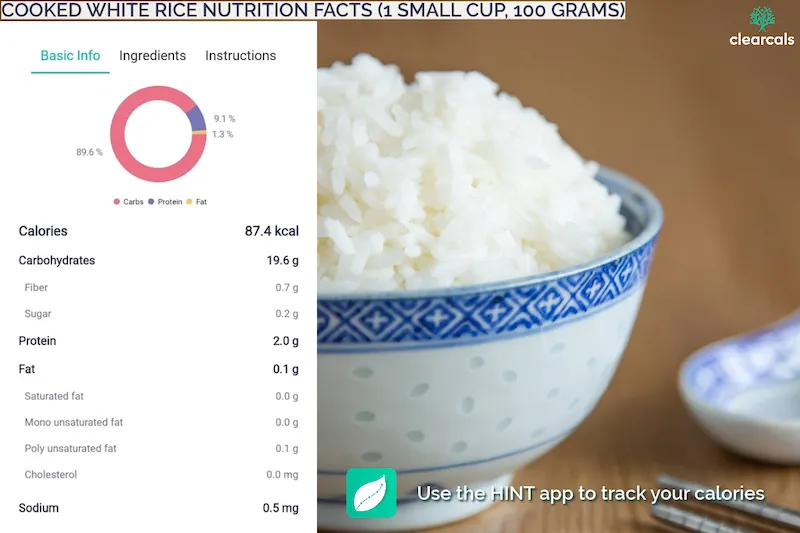
Written by Asfia Fatima, Chief Dietitian at Clearcals
TL;DR
- Nutritional Powerhouse: Rice is rich in carbohydrates and offers essential nutrients like B vitamins, magnesium, and manganese, making it a key energy source.
- Calorie Content: One small cup (100 grams) of cooked rice contains 88 kcal, providing a moderate calorie option for balanced meals.
- Health Benefits: Rice supports digestive health and is naturally gluten-free, making it suitable for various dietary needs.
- Versatile Ingredient: Rice can be used in countless dishes, from savory bowls to sweet desserts. Track your rice intake with the Hint app for personalized dietary insights.
Introduction
Rice is a dietary staple for over half of the world's population, offering versatility, affordability, and a rich nutritional profile. Whether you're enjoying a comforting bowl of white rice or savoring the nutty flavor of brown rice, this grain plays a significant role in cuisines across the globe.
In this blog, we’ll delve into rice's calorie content, nutritional benefits, and overall health advantages.
Plus, with advanced features like calorie tracking and nutrient analysis available through the Hint app, including Hint Pro and Hint Premium subscriptions, you can make informed choices about your rice consumption and support your wellness goals.
How Many Calories Are in Rice?
One small cup (100 grams) of cooked rice contains 88 kcal. However, the calorie content varies depending on the serving size. Here’s a breakdown of how calories increase with quantity and serving sizes:
| Rice Quantity | Rice Calories (kcal) |
|---|---|
| 50 grams | 44 |
| 100 grams | 87 |
| 200 grams | 175 |
| 250 grams | 218 |
| 300 grams | 262 |
| 500 grams | 437 |
| 1 kg | 874 |
| Rice Serving Size | Rice Calories (kcal) |
|---|---|
| 1 Bowl (100 grams) | 87 |
| 1 Small Cup (100 grams) | 87 |
| 1 Medium Cup (200 grams) | 175 |
| 1 Large Cup (300 grams) | 262 |
| 1 Small Plate (100 grams) | 87 |
| 1 Medium plate (200 grams) | 175 |
| 1 Large Plate (300 grams) | 262 |
Rice Calories Depend on Cooking Method and Water Quantity
The calories and nutrition profile of cooked rice can vary significantly based on how it’s prepared. The two main factors that influence its calorie density are:
- Amount of water used during cooking
- Use of added ingredients such as oil, ghee, or coconut milk
For example:
- Cooking rice with excess water and draining it can slightly reduce the starch content.
- Using less water results in denser rice with more calories per 100g.
- Adding ghee, clarified butter, or tempering (tadka) increases fat and overall calories.
That’s why a “bowl of rice” can have very different calorie values depending on region, recipe, and even the type of rice used (e.g., white rice vs brown rice vs basmati).
🧠 Note: The calorie values mentioned in this blog and in the Hint nutrition database are based on standard cooked rice without oil or added fat. Your actual values may differ.
🔄 Raw vs. Cooked Rice: Nutrient Comparison
Rice provides a variety of essential nutrients, making it an excellent addition to a balanced diet. Here's a general comparison of 100 grams of raw vs. cooked white rice (plain, boiled, no oil):
Raw White Rice (100g)
| Nutrients in Raw Rice | Amount per 100 grams |
|---|---|
| Calories (kcal) | 356 |
| Carbohydrates (grams) | 78.24 |
| Protein (grams) | 7.94 |
| Fat (grams) | 0.52 |
| Dietary Fiber (grams) | 2.81 |
| Sugar (grams) | 0.69 |
| Sodium (milligrams) | 2 |
| Potassium (milligrams) | 108 |
| Manganese (milligrams) | 0.7 |
| Vitamin B5 (milligrams) | 0.6 |
| Vitamin B6 (milligrams) | 0.1 |
Cooked White Rice (100g, plain)
| Nutrients in Cooked Rice | Amount per 100 grams |
|---|---|
| Calories (kcal) | 87 |
| Carbohydrates (grams) | 19.6 |
| Protein (grams) | 2.0 |
| Fat (grams) | 0.1 |
| Dietary Fiber (grams) | 0.7 |
| Sugar (grams) | 0.2 |
| Sodium (milligrams) | 0.5 |
| Potassium (milligrams) | 27 |
| Manganese (milligrams) | 0.2 |
| Vitamin B5 (milligrams) | 0.1 |
| Vitamin B6 (milligrams) | 0.0 |
These values can vary based on rice type (e.g., parboiled, brown, basmati) and cooking technique (pressure cooking, open pot, rice cooker, etc.).
Want to know the exact calories in your rice recipe?
Download the Hint app and use the “Create Your Recipe” feature to log your ingredients, adjust quantities (including water and fat), and get a personalized calorie and nutrition profile instantly.
For more insights into calories in Indian dishes, check out our Indian Food Calorie Calculator blog.
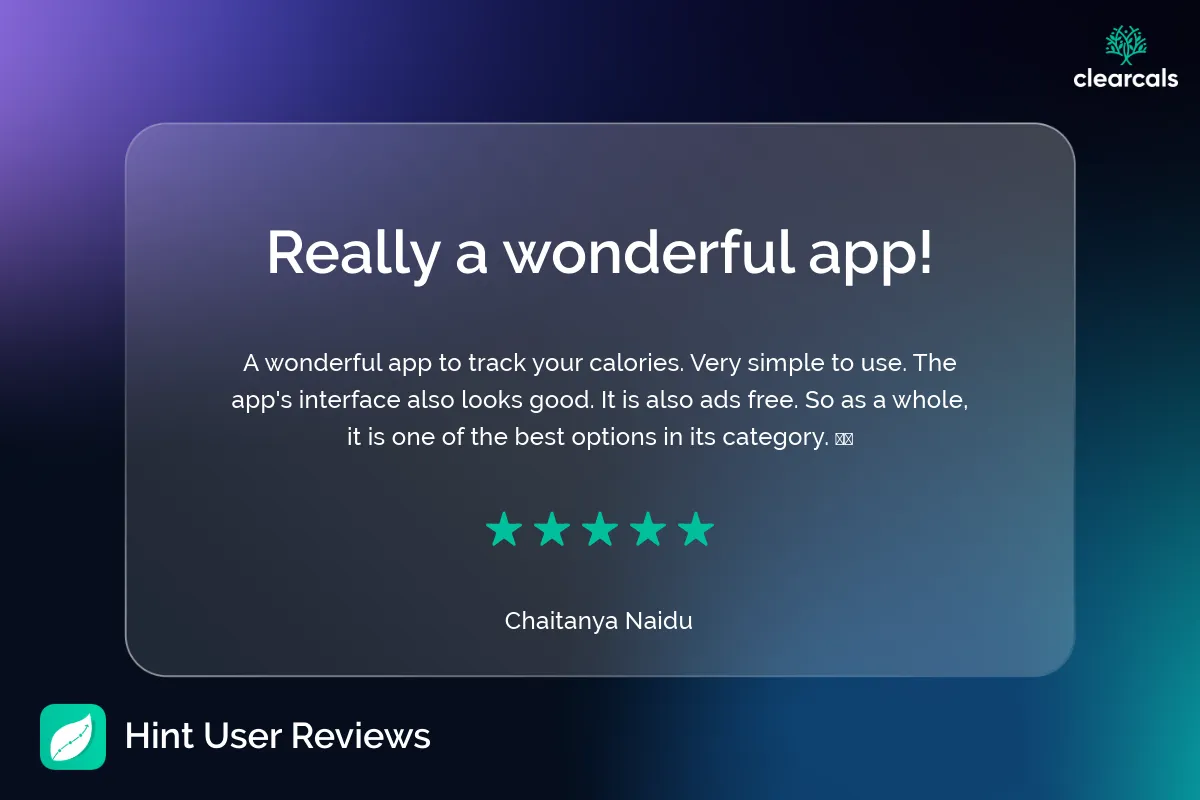
Incorporate Rice into Your Diet with the Hint App
The Hint app provides a comprehensive solution to track rice intake and other nutrients.
Whether you’re managing weight or diabetes, or simply aiming for a balanced diet, you can rely on the Hint Pro and Hint Premium subscriptions for advanced calorie tracking, personalized diet plans, and expert dietitian consultations.
- Hint Pro: Gain access to a personalized diet plan tailored to your health goals, be it weight loss, muscle gain, or balanced nutrition.
- Hint Premium: Enjoy unlimited consultations with expert dietitians, allowing you to adjust your diet based on ongoing feedback and track nutrient intake more effectively.
Watch: How to Track Rice Calories on the Hint App
Rice Benefits
- Good Source of Energy: Rice is rich in carbohydrates, which serve as the primary energy source for the body. It provides slow-releasing energy, keeping you full and energized throughout the day.
- Rich in Fiber (Especially Brown Rice): Fiber is essential for digestive health, and brown rice, which contains the bran and germ of the grain, is particularly high in fiber. This can help reduce cholesterol and promote gut health.
- Packed with Vitamins and Minerals: Rice is a good source of B vitamins like thiamin, niacin, riboflavin, and minerals like magnesium, iron, and potassium. These nutrients are critical in metabolism, immune function, and heart health.
- Naturally Gluten-Free: Rice is inherently gluten-free, making it an excellent option for people with celiac disease or gluten sensitivity.
- Supports Heart Health: Studies have shown that whole grains, such as brown rice, are associated with a lower risk of heart disease. A diet rich in whole grains can help improve cholesterol levels and reduce the risk of cardiovascular conditions.
- Helps Control Blood Sugar Levels: Brown rice has a low glycemic index, which means it doesn’t cause a rapid spike in blood sugar levels. This makes it an ideal option for people managing diabetes or prediabetes.
- Aids in Weight Loss: Rice is a low-calorie food that promotes satiety. It can help control hunger, making it easier to maintain a calorie deficit for weight loss.
Top Rice Recipes and Their Calorie Content
Explore how the calorie content of popular Indian rice dishes changes based on ingredients, portion size, and cooking style.
From plain steamed rice to fried rice and curd rice, get a breakdown of calories for each recipe — and learn how to estimate your own with the Hint app’s personalized recipe tracker.
1. Fried Rice Calories: A Versatile and Flavorful Dish
Fried rice is a beloved dish made by stir-frying pre-cooked rice, often combined with a medley of vegetables, proteins, and a range of seasonings or sauces.
Its versatility allows for endless variations across different cultures, with unique ingredients adding distinct flavors to each recipe.
Whether you prefer it with chicken, eggs, or vegetables, fried rice can be adapted to suit various tastes and nutritional needs. Let’s explore some popular variations and their calorie content.
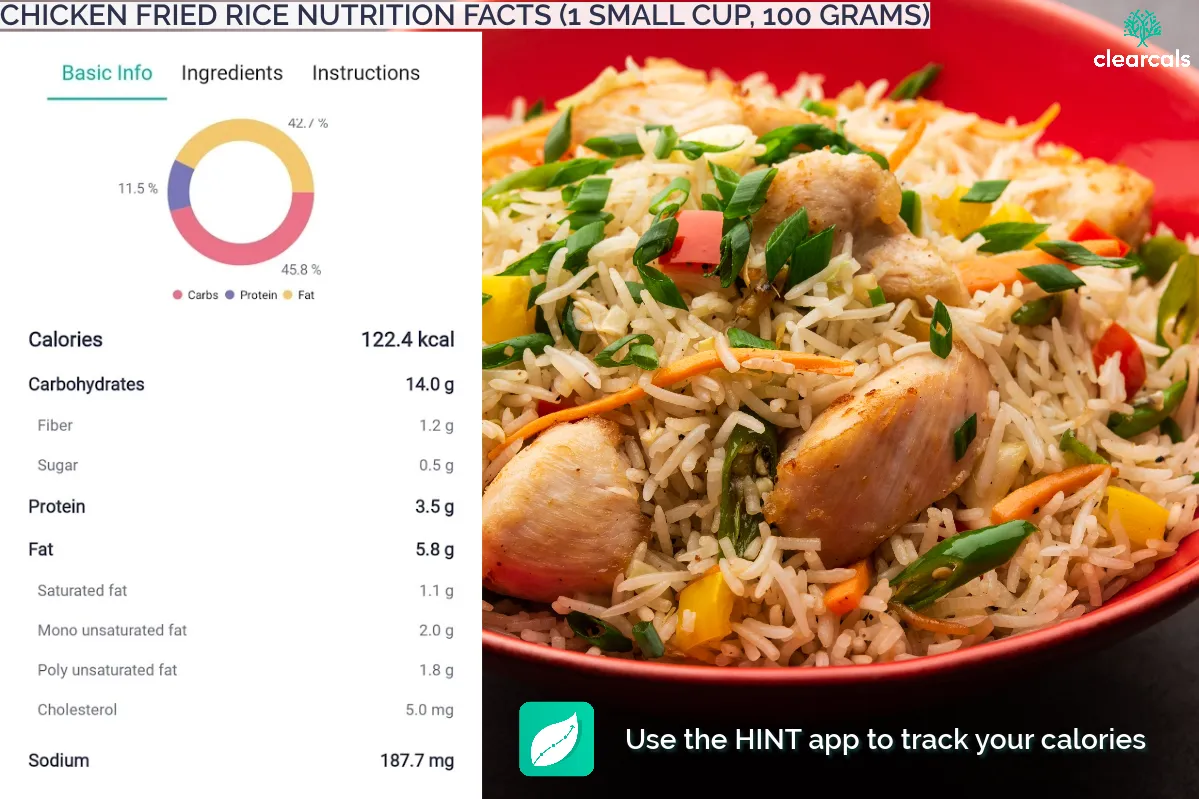
Chicken Fried Rice Calories
A small cup (100 grams) of chicken fried rice contains 122 kcal, with 46% of the calories coming from carbohydrates, 11% from protein, and 43% from fat.
Chicken fried rice is a good source of protein and essential nutrients such as vitamin C, niacin, copper, vitamin B5, and B6. It also provides beta-carotene and vitamin E, making it a nutrient-packed option.
Tip: Enjoy chicken fried rice in moderation, as it can contain trans fats depending on the cooking method.
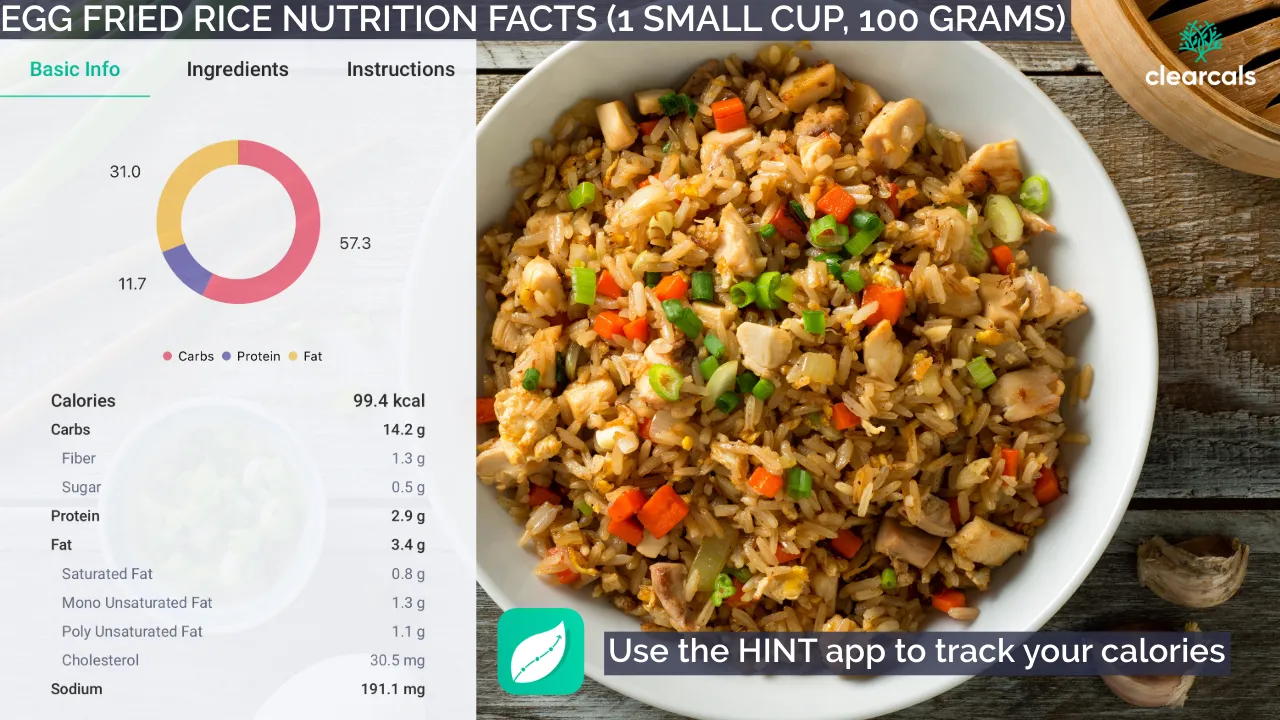
Egg Fried Rice Calories
In one small cup (100 grams) of egg-fried rice, you'll find 99 kcal, with 57% of the calories derived from carbohydrates, 12% from protein, and 31% from fat.
Egg fried rice is rich in protein and offers vitamins like B5 and B6, as well as beta-carotene, vitamin C, and E. It’s a delicious way to include both carbohydrates and protein in a single meal.
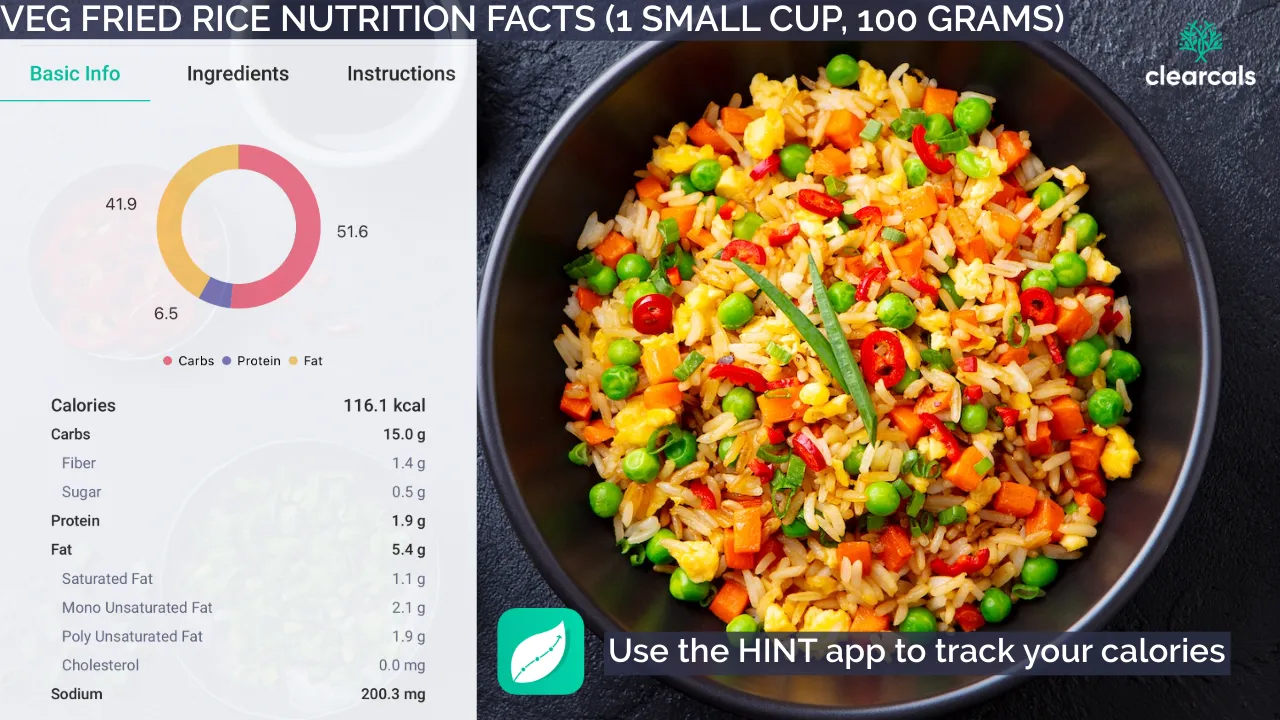
Vegetable Fried Rice Calories
A small cup (100 grams) of vegetable fried rice contains 116 kcal, with 52% of the calories from carbohydrates, 6% from protein, and 42% from fat.
Vegetable fried rice is a good source of fiber and essential nutrients like manganese, beta-carotene, and vitamin C. It’s also an excellent way to get additional fiber into your diet. Tip: Like other fried rice dishes, eat it in moderation as it can contain trans fats.
Calories in Various Fried Rice Recipes
The calorie content of fried rice can vary depending on the ingredients and preparation methods. Here’s a quick overview of calories per small cup (100 grams) for different fried rice variations:
| Fried Rice Variation | Calories (kcal) in 1 small cup (100 grams) |
|---|---|
| Chicken Fried Rice | 122 |
| Egg Fried Rice | 99 |
| Vegetable Fried Rice | 116 |
| Corn Fried Rice | 96 |
| Garlic Fried Rice | 96 |
| Mushroom Corn Fried Rice | 101 |
| Paneer Fried Rice | 110 |
| Prawns Fried Rice | 113 |
| Soya Chunks Fried Rice | 116 |
| Schezwan Mushroom Fried Rice | 119 |
| Schezwan Paneer Fried Rice | 136 |
| Schezwan Egg Fried Rice | 140 |
| Schezwan Chicken Fried Rice | 146 |
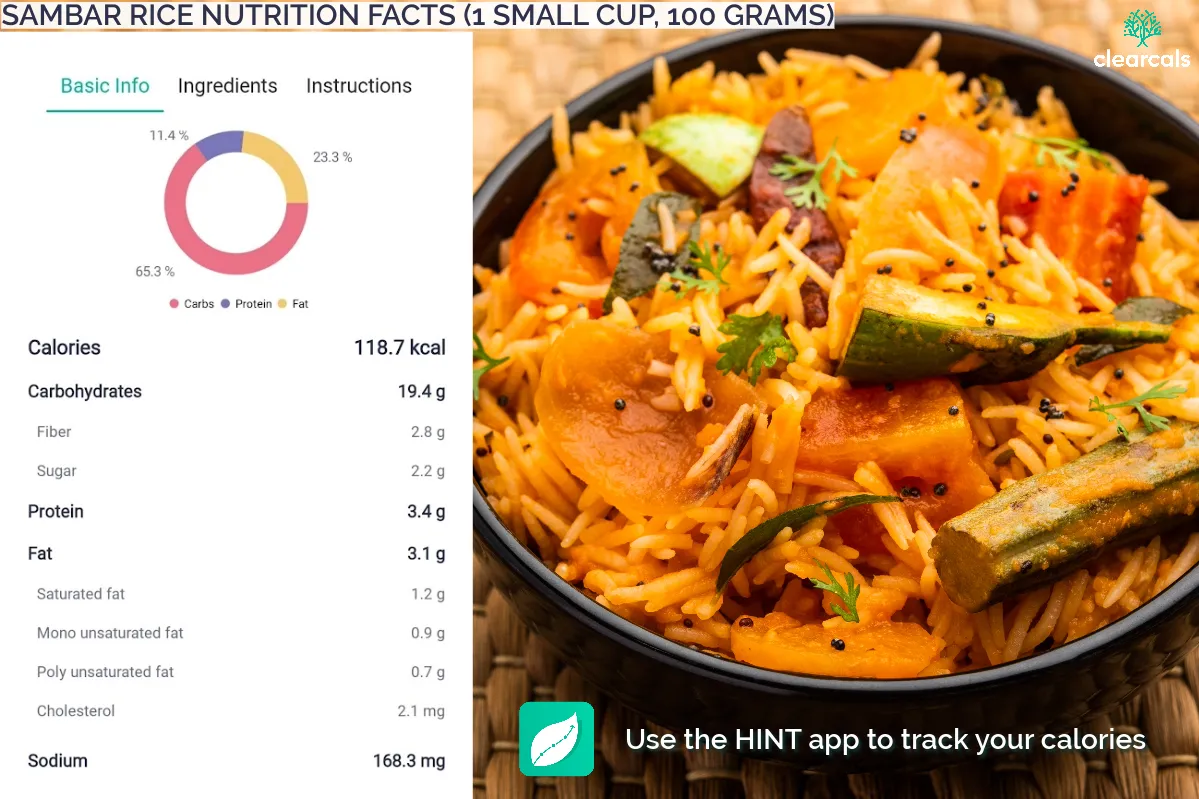
2. Sambar Rice Calories
A small cup (100 grams) of sambar rice contains 119 kcal, with 65.3% of the calories coming from carbohydrates, 11.4% from protein, and 23.3% from fat.
Sambar rice is not only delicious but also highly nutritious. It’s a good source of protein and dietary fiber, which aid digestion and help you feel full for longer.
Additionally, it provides essential minerals like potassium, phosphorus, magnesium, and manganese, along with vitamins such as B5, C, and E. Rich in beta-carotene, lutein, copper, and vitamin D, sambar rice can support a variety of health goals, including improving digestion and aiding in weight loss.
Using the Hint app, you can easily track your calorie intake from meals like sambar rice, ensuring you stay within your daily nutritional goals.
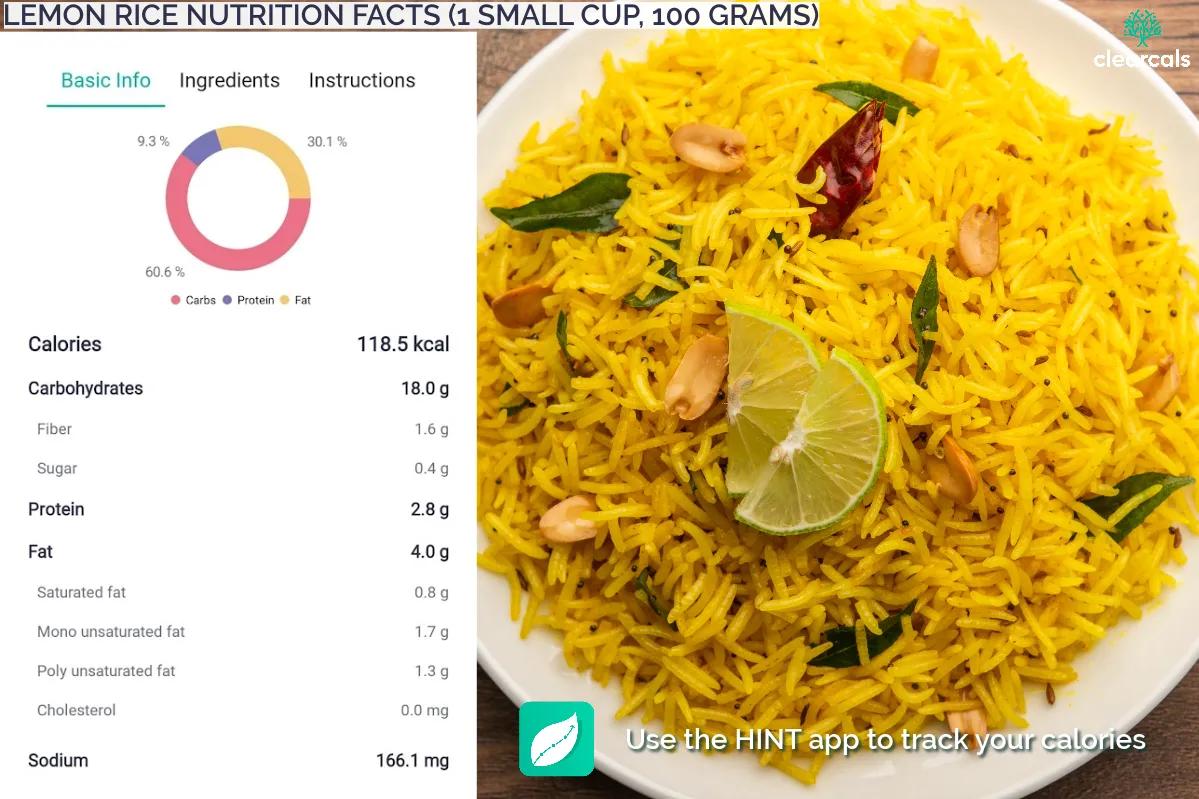
3. Lemon Rice Calories
A small cup (100g) of lemon rice has 119 kcal, with 60.6% from carbs, 9.3% from protein, and 30.1% from fat. This balanced dish offers a moderate amount of protein and healthy fats, making it a flavorful addition to your meals.
Easily track your lemon rice intake with the Hint app to manage your daily calories.
Lemon Rice Benefits
Lemon rice is not only tasty but also provides key nutrients. It’s a good source of protein, copper, and manganese, which support metabolism and bone health. Rich in beta carotene, lutein, and vitamin E, it boosts eye health and offers antioxidants. It's vitamin D content strengthens bones and immunity.
Use the Hint app to monitor your nutrient intake for better bone health and overall wellness.
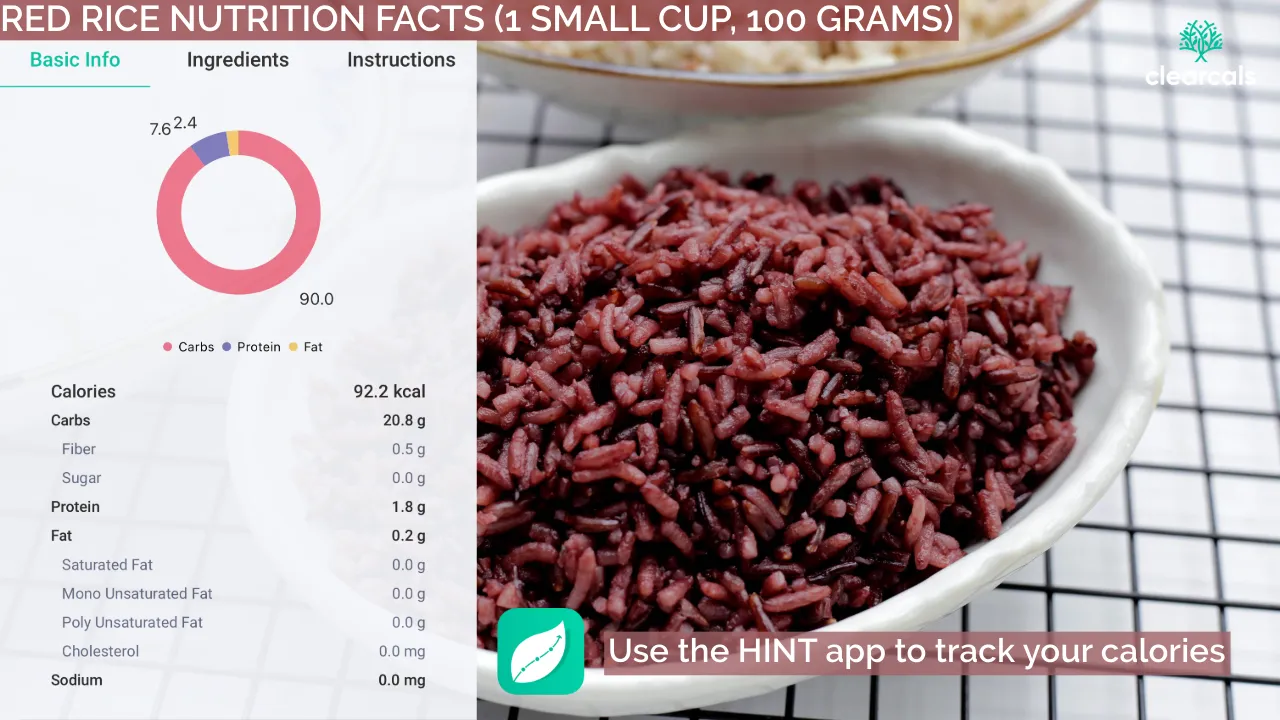
4. Red Rice Calories
A small cup (100g) of red rice contains 92 kcal, with 90% from carbs, 7.6% from protein, and 2.4% from fat. Red rice is a low-calorie, nutrient-rich option that provides long-lasting energy.
Track your portion sizes with the Hint app to manage your calorie intake effectively.
Red Rice Benefits
Red rice is packed with fiber, helping digestion and maintaining cholesterol levels.
It’s rich in antioxidants and nutrients like magnesium and manganese, which contribute to heart health and overall well-being. Regular consumption of red rice promotes a balanced diet and supports longevity.
Easily track your nutritional intake with the Hint app.
Is Red Rice Good for Diabetes?
Yes, red rice is ideal for managing diabetes. Its low glycemic index ensures a steady rise in blood sugar, improving insulin sensitivity. The high fiber content also aids digestion and slows sugar absorption.
Track your red rice intake and monitor blood sugar levels with the Hint app, which offers personalized meal plans for diabetes management.

5. Puffed Rice Calories
100 grams of puffed rice contains approximately 355 kcal, with 87.5% of its calories coming from carbohydrates, 8.4% from protein, and 4.1% from fat.
While puffed rice is a light and low-calorie snack, it's important to note that 100 grams of puffed rice is quite voluminous. A small cup can only accommodate much less than 100 grams, meaning that the actual calorie content of a small cup is significantly lower than 355 kcal. This makes it an easy snack to fit into your diet without consuming too many calories at once.
Track your intake using the Hint app for better portion control.
Puffed Rice Nutrition
Puffed rice is rich in phosphorus, magnesium, iron, and zinc. It also provides essential B vitamins like niacin and pantothenic acid, making it a nutritious addition to meals.
The Hint app can help you track these nutrients and maintain a balanced diet.
Puffed Rice Benefits
Puffed rice is low-calorie, easy to digest, and high in fiber, which aids digestion and keeps you full longer. It’s also a good source of iron, which supports healthy blood circulation. Combine it with fresh ingredients for a healthy snack.
Is Puffed Rice Good for Health?
Yes, puffed rice is healthy when consumed in moderation. It’s low in calories, light on digestion, and heart-healthy. For maximum benefits, avoid processed varieties and pair them with veggies or fruits.
Is Puffed Rice Good for Weight Loss?
Puffed rice can help with weight loss due to its low-calorie, filling nature. Combine it with nutrient-dense foods like vegetables or lean proteins for a balanced snack.
Use the Hint app to monitor calories and stay on track.
Is Puffed Rice Good for Diabetes?
Yes, puffed rice can be suitable for diabetes when eaten in moderation. Pair it with low-GI foods to prevent blood sugar spikes.
The Hint app helps track your carb intake to ensure it fits into your diabetes meal plan.
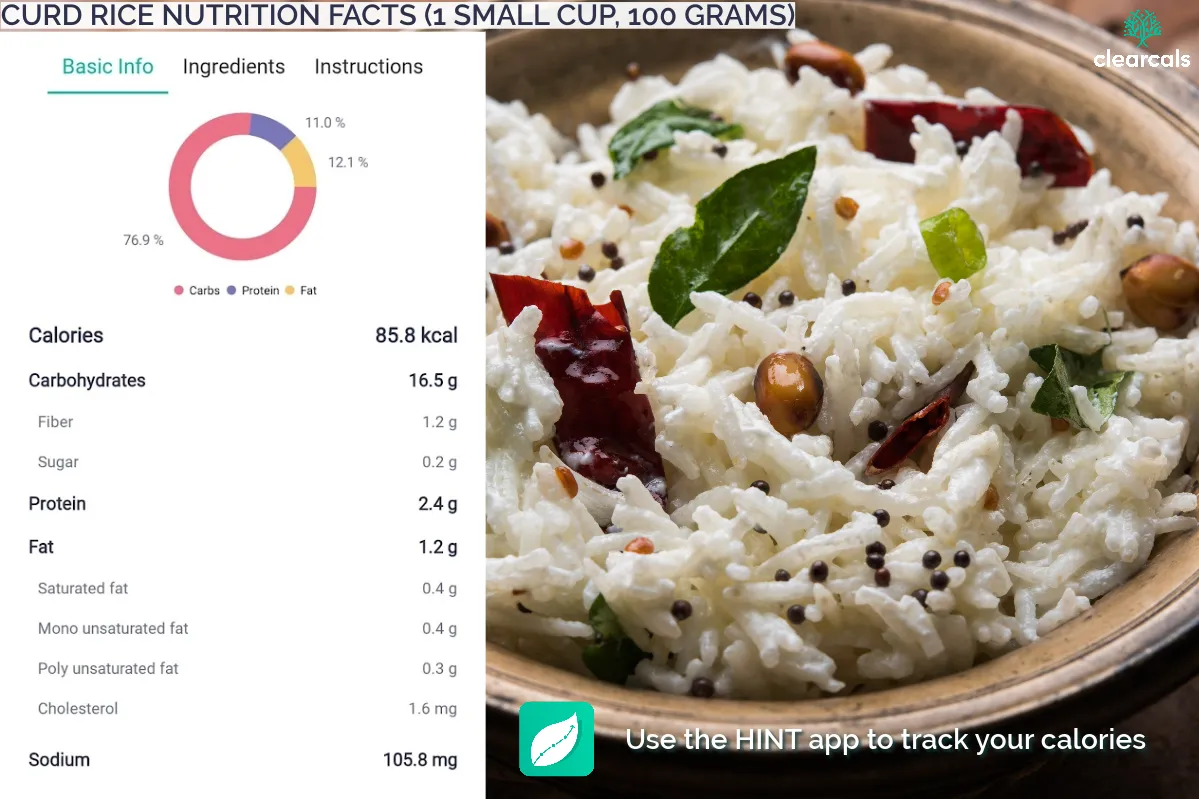
6. Curd Rice Calories
A small cup (100g) of curd rice contains 86 kcal, with 76.9% of the calories from carbohydrates, 11% from protein, and 12.1% from fat.
Curd rice is a light and refreshing dish, perfect for those looking to enjoy a flavorful meal without consuming too many calories.
Use the Hint app to track your curd rice intake and stay on top of your calorie goals.
Curd Rice Benefits
Curd rice is a powerhouse of health benefits. It’s rich in probiotics, which support gut health and digestion.
It also provides essential nutrients like manganese, beta-carotene, and vitamin D, promoting stronger bones and improved immune function. Adding curd rice to your diet can help soothe the stomach and promote better digestion.
Track its nutrients using the Hint app for a more balanced diet.
Is Curd Rice Good for Weight Loss?
Yes, curd rice can aid in weight loss when consumed in moderation. Its low-calorie content, combined with the filling nature of curd, helps keep you satisfied without overeating.
The probiotics in curd also improve digestion, which can contribute to healthier weight management.
Use the Hint app to monitor portion sizes and track your progress toward weight loss goals.
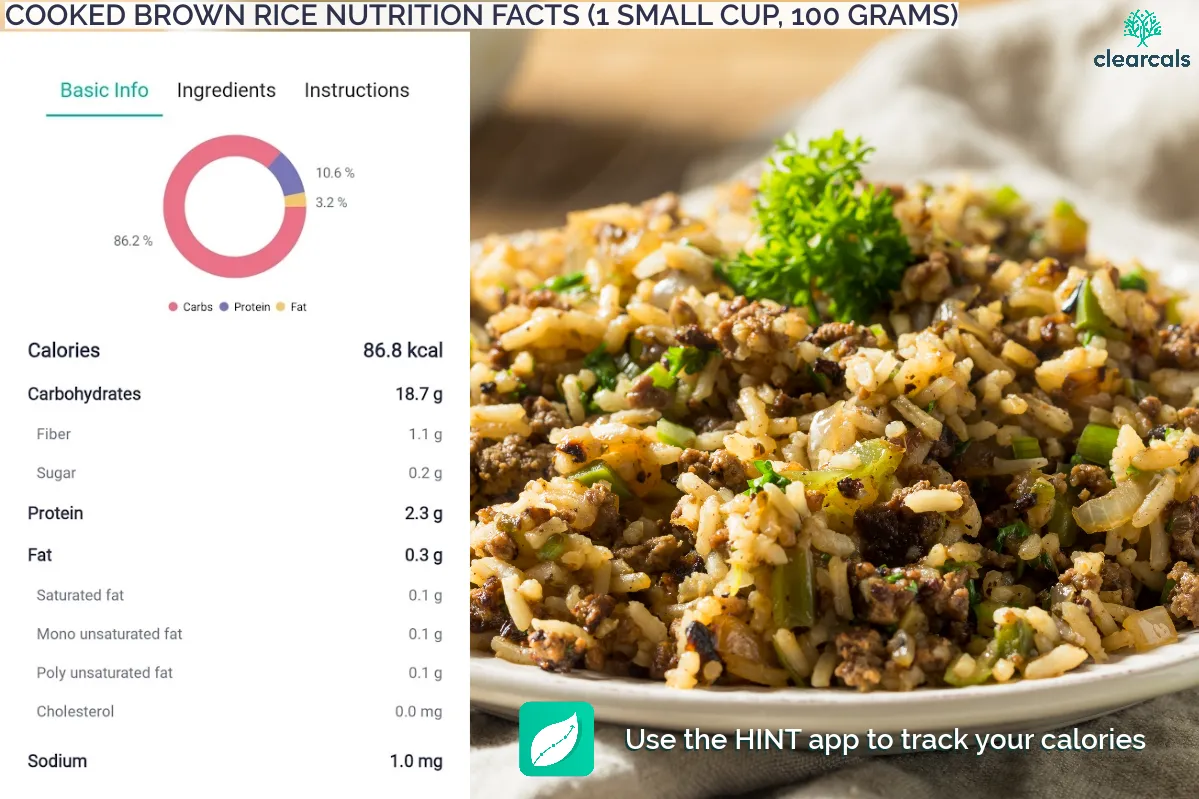
7. Brown Rice Calories
A small cup (100g) of brown rice contains 87 kcal, with 86.2% of the calories coming from carbohydrates, 10.6% from protein, and 3.2% from fat.
Brown rice is a nutrient-dense, low-calorie option that provides sustained energy, making it ideal for balanced meals.
Track your brown rice intake using the Hint app to ensure you're meeting your calorie and nutrition goals.
Brown Rice Protein
Brown rice is a good plant-based source of protein, providing around 2 grams of protein per 100g serving.
While it’s not as high in protein as animal-based foods, it offers a valuable protein boost, especially for those following vegetarian or vegan diets.
Combine brown rice with legumes for a complete protein meal, and track your protein intake with the Hint app to optimize your diet.

8. Basmati Rice Calories
A small cup (100g) of basmati rice contains 85 kcal, with 90.8% of the calories coming from carbohydrates, 7.9% from protein, and 1.3% from fat.
Basmati rice is a low-calorie option that adds flavor and texture to your meals while keeping your caloric intake in check.
Track your basmati rice consumption easily using the Hint app.
Basmati Rice Benefits
Basmati rice is not only fragrant but also packed with health benefits. It’s a good source of complex carbohydrates, providing steady energy release.
It also contains essential nutrients like magnesium, thiamine, and fiber, promoting heart health and digestion. Basmati rice’s low glycemic index makes it a healthier rice option for a balanced diet.
Use the Hint app to monitor your nutrients and create balanced meals.
Is Basmati Rice Good for Diabetics?
Yes, basmati rice is a better choice for diabetics compared to other rice varieties due to its low glycemic index.
It causes a slower rise in blood sugar, helping to control insulin levels. For those managing diabetes, pairing basmati rice with high-fiber vegetables or proteins can further stabilize blood sugar.
Track your meals and blood sugar impact with the Hint app for a more diabetes-friendly diet.
Is Basmati Rice Good for Weight Loss?
Yes, basmati rice can aid in weight loss when eaten in moderation. It’s low in calories and contains fiber, which helps you feel fuller for longer.
Its complex carbohydrates provide sustained energy without causing rapid spikes in blood sugar, which can aid in managing hunger and cravings.
Use the Hint app to track your portion sizes and stay on target with your weight loss goals.
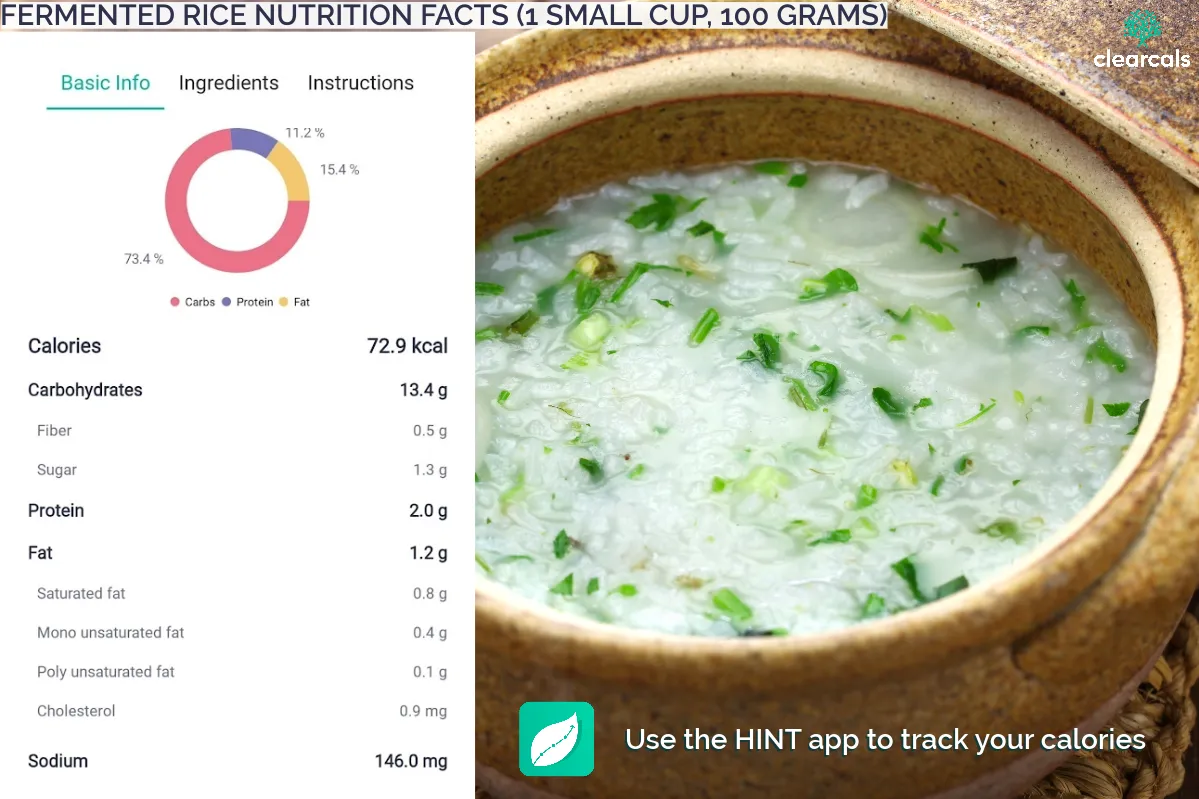
9. Fermented Rice Calories
A small cup (100g) of fermented rice contains 73 kcal, with 73.4% of the calories coming from carbohydrates, 11.2% from protein, and 15.4% from fat.
Fermented rice is a low-calorie option that also offers a boost in protein, making it a nutritious and filling dish.
Easily track your fermented rice intake with the Hint app to manage your calories and nutrients.
Fermented Rice Benefits
Fermented rice is packed with health benefits. It’s rich in probiotics, which improve gut health and digestion, and contains essential nutrients like B vitamins, magnesium, and iron.
Fermentation also enhances the bioavailability of nutrients, making them easier for your body to absorb. Regular consumption of fermented rice can boost immunity, improve digestion, and support overall well-being.
Use the Hint app to monitor your nutrient intake and make healthier food choices.
Conclusion
Rice is more than just a versatile grain; it’s a nutritional powerhouse that supports energy levels, heart health, and digestion.
By incorporating rice into your diet, you can enjoy its numerous health benefits, from helping control blood sugar to aiding in weight loss.
With the Hint app and its advanced features, you can track your rice consumption and other nutrients to maintain a balanced diet aligned with your wellness goals.
Whether you choose Hint Pro for personalized diet plans or Hint Premium for expert consultations and deeper insights, you’ll have the tools you need to stay on track.
Download the Hint app today and start your journey toward better health with rice as a nutritious staple.
Frequently Asked Questions
1. Does Rice Make You Fat?
Rice itself doesn’t cause weight gain when eaten in moderation. It’s all about portion control and balance. White rice is higher in carbs but low in fat.
However, pairing rice with nutrient-dense foods like vegetables, lean proteins, and healthy fats can prevent overeating.
Choosing whole grain varieties like brown rice or red rice adds fiber, helping you feel full longer and support weight management.
Use the Hint app to track your portion sizes and maintain a balanced diet.
2. Which Rice is Good for Diabetes?
Basmati rice and brown rice are better choices for individuals with diabetes due to their low glycemic index.
These rice varieties cause a slower rise in blood sugar, helping manage insulin levels more effectively than regular white rice.
Incorporating high-fiber and protein-rich foods alongside these rice options can further stabilize blood sugar levels.
The Hint app can help you track your meals and maintain a diabetes-friendly diet.
3. Is rice good for weight loss?
Yes, when consumed in moderation, rice can be part of a weight-loss plan. Opt for whole grain varieties like brown rice for higher fiber content.
4. Is rice gluten-free?
Yes, all varieties of rice, including white, brown, and wild rice, are naturally gluten-free.
5. What is the difference between white and brown rice?
Brown rice is a whole grain, containing more fiber and nutrients than white rice, which has had the bran and germ removed.
6. What are the health benefits of black and red rice?
Both are rich in antioxidants and fiber, supporting heart health and digestion.
For more information on how rice can fit into your diet, download the Hint app and explore detailed nutritional insights tailored to your needs.
Exclusive Offer: Enjoy One Month of Free Hint Premium Access
When you purchase any of the select Garmin Watches from the Clearcals Store, you'll receive one month of free Hint Premium (worth Rs. 1999), which includes:
✅ Unlimited dietitian consultations
✅ Personalized diet and workout plans
✅ Advanced calorie and nutrition tracking
🚀 Visit the Clearcals Store today and unlock your free Hint Premium access!
About the Author
Asfia Fatima is the Chief Dietitian at Clearcals, with a Master’s Degree in Dietetics and Clinical Nutrition and over a decade of experience in clinical nutrition and lifestyle management.
She specializes in evidence-based diet planning for weight loss, diabetes, and metabolic health.
At Clearcals, she leads the nutrition strategy behind the Hint app, helping users achieve their goals with science-backed guidance.
🔗 Connect with Asfia on LinkedIn





